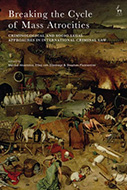Breaking The Cycle Of Mass Atrocities: Criminological And Socio-Legal Approaches In International Criminal Law

Editors: Marina Aksenova, Elies van Sliedregt and Stephan Parmentier.
Publisher: London: Hart/Bloomsbury Publishing: 2019. 268p.
Reviewer: Lynn Rapaport | September 2020
Breaking the Cycle of Mass Atrocities is an edited volume focusing on distinct phases of collective violence and the role of international criminal law at each stage. The book is organized into five parts: Part I, The Cycle of Mass Atrocities; Part II, Criminalisation; Part III: Trial and Punishment; Part IV, Re-entry of Victims and Perpetrators; and Part V, Prevention. The volume concludes with an epilogue that summarizes the arguments in the volume, demonstrates gaps in the legal framing of mass atrocities, and argues for a more comprehensive multidisciplinary perspective in developing international criminal law.
Part I includes an Introduction by Marina Aksenova that describes the structure of the book and a description of each part. She advocates for including sociological and criminological perspectives in international law since increasing importance is being placed on regional and national courts, thus questioning the legitimacy of international courts. Using multidisciplinary perspectives can help connect the regional and international criminal law and justice by providing a larger context in which to prosecute collective violence. In a disappointing chapter by Christopher Harding on “The Biology and Psychology of Atrocity and the Erasure of Memory,” he uses literary examples to highlight how memory and its erasure impact human nature by looking at the psychology and personal pathology of atrocity. While Harding acknowledges that his discussion is speculative and tentative, it is precisely because of the lack of grounded empirical analysis that this chapter seems out of place with the rest of the volume.
Matilde Gawronski’s fascinating chapter on “International Criminalisation as a Pragmatic Institutional Process” opens Part II on Criminalisation. Gawronski compares two different cases deriving from crimes committed by the Lord’s Resistance Army (LRA) between 1986 and 2008 in Uganda. The first case is of Dominic Ongwen, who was tried by the International Criminal Court (ICC) in The Hague, and the second is of Thomas Kwoyelo, who was tried by the International Crimes Division (ICD) in Uganda. The author shows how both cases evolved differently based on how they were created for prosecution, and coins the term “pragmatic criminalization,” the interplay between an institution’s capacity for prosecution and the legal framework available to it. In chapter 4, Marina Aksenova takes a Durkheimian perspective to analyze the moral and legal basis for crimes against humanity. She argues that the legitimacy of crimes against humanity comes from the violation of feelings collectively shared (or conscience collective) among individuals across state borders. International prosecutions and punishment following the crime enhance solidarity across national borders.
In Part III, Trial and Punishment, Colleen Rohan challenges the assumption that International Criminal Law (ICL) is applied consistently across various international courts. She shows how ICL courts have only existed for about 25 years, use a “hybrid system of law” comprised of a mix of Western civil and common law traditions (99), and is not consistently utilized in all ICL courts. This can lead to dissonance and unfairness when select portions of the civil or common law systems are taken out of the international context and relied upon as they would be in a domestic proceeding. In a fascinating chapter by Kerstin Bree Carlson, she illustrates the “agency paradox” by focusing on the culpability of prison guards, whereby individual guilt is ascribed for a collective crime. She questions who gets prosecuted in international criminal law—leaders or followers–and shows how theories of liability are not clear cut in criminal law. Barbora Holá and Amanani Chibashimba’s chapter 7 compares post-genocidal sentencing practices in Rwandan domestic courts with the United Nations International Criminal Tribunal for Rwanda (ICTR), and shows differences in punishment practices and severity. They find that the punishment for those considered ‘the most responsible’ in Rwandan domestic courts appear harsher than those determined by the ICTR, and argue that context matters greatly when trying to understand and compare punishment across different jurisdictions.
The Re-Entry of Victims and Perpetrators (Part IV) opens with Milena Tripkovic’s chapter 8, “Not in Our Name! Visions of Community in International Criminal Justice.” Focusing on the International Criminal Tribunal for the former Yugoslavia (ICTY), Tripkovic argues that international prosecutions cannot be expected to reaffirm common morality and social solidarity, given a lack of a shared perspective that the ICTY acts in the name of and benefits the internally divided ex-Yugoslav community. In Chapter 9, “Explaining (Away) Individual Agency: A Criminological Take on Direct Perpetrator Re-Presentations at the ICTY,” Anette Brindedahl Houge takes an in-depth look at the narratives the court produces, and its meanings and functions. She argues that prosecutors overemphasize individual agency, whereas defense counsels mitigate or deny agency by drawing on narratives of collective violence, and that these narratives contribute to the social construction and understanding of the crimes addressed and the actors involved.
The volume concludes with Part V, Prevention. Stefan Harrendorf’s “Social Identity and International Crimes: Legitimate and Problematic Aspects of the ‘Ordinary People’ Hypothesis” argues that “criminality cannot simply be understood as deviance from legal and social norms” (215), but needs to take into account the “situational aspects” and adaptation and conformity with group norms. Elies Van Liedregt’s chapter, “Regional Criminal Justice, Corporate Criminal Liability and the Need for Non-Doctrinal Research,” examines the Malabo Protocol and its effectiveness for African justice. Liedregt examines whether the Malabo Protocol is a rebel initiative, criminalizing both international and transnational crimes — thus bringing regional and local justice closer to home, and allowing for corporate criminal liability in international criminal law.
All told, Breaking the Cycle of Mass Atrocities is a welcome addition to the literature, and should be of interest to scholars and students interested in socio-legal approaches to international criminal law.
Lynn Rapaport, Henry Snyder Professor of Sociology; Chair of Sociology, Pomona College


